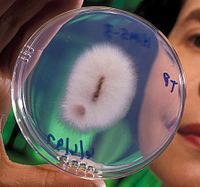
Photo from wikipedia
BackgroundPseudostellaria heterophylla (P. heterophylla), a herbaceous perennial, belongs to Caryophyllaceae family and is one of the Chinese herbal medicine with high pharmacodynamic value. It can be used to treat the… Click to show full abstract
BackgroundPseudostellaria heterophylla (P. heterophylla), a herbaceous perennial, belongs to Caryophyllaceae family and is one of the Chinese herbal medicine with high pharmacodynamic value. It can be used to treat the spleen deficiency, anorexia, weakness after illness and spontaneous perspiration symptoms. Our previous study found that consecutive monoculture of Pseudostellaria heterophylla could lead to the deterioration of the rhizosphere microenvironment. The specialized forms of pathogenic fungus Fusarium oxysporum f.Sp. heterophylla (F. oxysporum) in rhizosphere soils of P. heterophylla plays an important role in the consecutive monoculture of P. heterophylla.ResultsIn this study, F. oxysporum was used to infect the tissue culture plantlets of P. heterophylla to study the responding process at three different infection stages by using RNA-sequencing. We obtained 127,725 transcripts and 47,655 distinct unigenes by de novo assembly and obtained annotated information in details for 25,882 unigenes. The Kyoto Encyclopedia of Genes and Genomes pathway analysis and the real-time quantitative PCR results suggest that the calcium signal system and WRKY transcription factor in the plant-pathogen interaction pathway may play an important role in the response process, and all of the WRKY transcription factor genes were divided into three different types. Moreover, we also found that the stimulation of F. oxysporum may result in the accumulation of some phenolics in the plantlets and the programmed cell death of the plantlets.ConclusionsThis study has partly revealed the possible molecular mechanism of the population explosion of F. oxysporum in rhizosphere soils and signal response process, which can be helpful in unraveling the role of F. oxysporum in consecutive monoculture problems of P. heterophylla.
Journal Title: BMC Plant Biology
Year Published: 2017
Link to full text (if available)
Share on Social Media: Sign Up to like & get
recommendations!